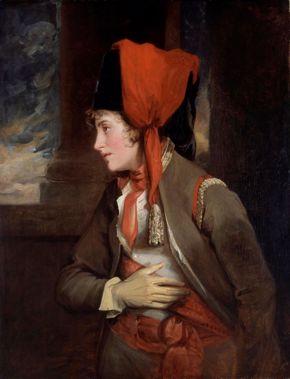The Characters of Kenwood: Mrs. Jordan August 3, 2012

John Hoppner, Mrs. Jordan as "Viola," c. 1785–92, oil on canvas, Kenwood House, English Heritage; Iveagh Bequest, 1927 (88028789)
During the run of the exhibition Rembrandt, Van Dyck, Gainsborough: The Treasures of Kenwood House, London, we will fill you in on the lives of the characters that add to the colorful history of the Kenwood estate. Quite a few of these 18th-century beauties—including actresses, courtesans, and other celebrities—would have recognized (and in some cases snubbed) each other had they entered the same reception rooms . . .
Dorothea Jordan was the leading comic actress of Georgian England, and in this portrait by English artist John Hoppner, she is painted in her role as Viola from Shakespeare’s Twelfth Night. In the play, Viola disguises herself as a man so she can be a page for the Duke of Orsino.
Mrs. Jordan (1761–1816) led a remarkable life and has been the subject of many biographies.
10 things to know:
- She was born Dorothy Bland. (Who can blame her for changing that name?)
- After becoming pregnant by her stage manager in 1782, she fled to Ireland and changed her surname.
- She was rumored to have flirtations and affairs with Prince William, Duke of Clarence and William IV, son of King George III. She must have had a thing for Williams!
- Mrs. Jordan publicly accepted William IV has her lover in 1790, causing quite the scandal.
-
She sat for portraits by artists including Joshua Reynolds, George Romney, John Russell, and of course John Hoppner.
(Unfortunately for her, after the public scandal of becoming Prince William’s lover, she was also the subject of caricaturists such as James Gillray. Another unfortunate association noted by these artists was that “Jordan” was a term used for the toilet.) - In addition to the child she had by her stage manager in Ireland, she had four more children prior to meeting Prince William. During her relationship with him, she had 10 more children!
- She died abruptly only a year after Prince William separated from her. They had been together for 20 years.
- Out of guilt, he bought every portrait of her he could find.
- Edward Cecil Guinness paid £1,217 for this portrait in 1894, almost double the price of what most of Hoppner’s works were selling for at that time.
- In the Dictionary of National Biography (1882) she was described as “An adventuress of uncertain virtue.”
To see the fabulous renditions of these personalities up close, visit the exhibition—organized by the American Federation of Arts and English Heritage—while it is on view at the MFAH this summer.





